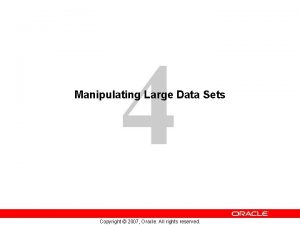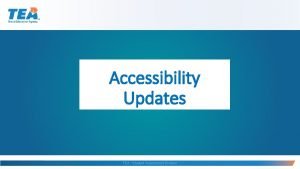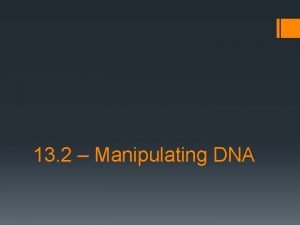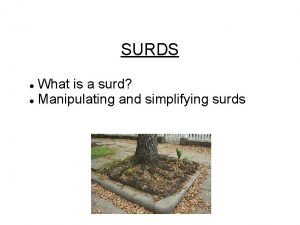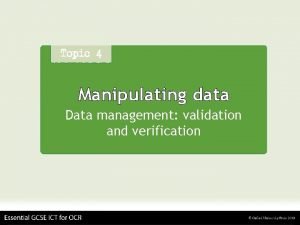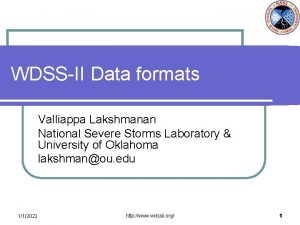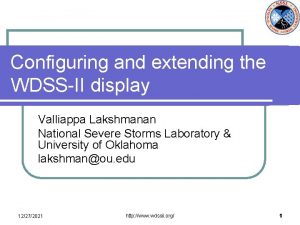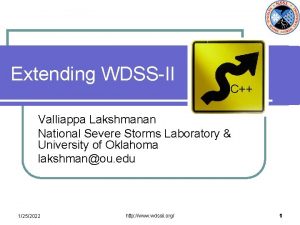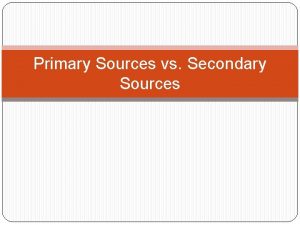WDSSII Training Module II Manipulating Data Sources Data












- Slides: 12

WDSS-II Training Module II Manipulating Data Sources

Data files n Data are stored in files n n n Separate files for each elevation scan, table, Lat. Lon. Grid slice, contour, etc Each file corresponds to one time-stamp Separate files as the data streams in Usually organized by product name Usually netcdf or XML format Details in data format section

Data Sources n The data files are organized n Based on the sensor(s) it is from n n Called a data source Each data source has an “index” file n n n Radar, satellite, model, METAR, etc. Combined from these 6 radars Lists which data are available How to get a hold of the data Usually all the data are in one directory n n But may be distributed The index will however be in one “well-known” spot

Indices: XML versus XMLLB n All index records are in XML format in one of two file types: n XML LB files (code_index. lb): can have up to 32, 500 records; handle notification; binary file must be accesses with lb_cat, etc. n n algorithms that use an xmllb: as input will never exit! XML text files: user-editable, can have an unlimited number of records n Algorithms that use an xml: index as input will exit when they reach the end of the file.

Example of an index record <item> <time fractional="0. 0"> 799875952 </time> <params>netcdf {indexlocation} Velocity 00. 50 19950507 -194552. netcdf. gz</params> <selections>19950507 -194552 Velocity 00. 50 </selections> </item> More details in session on data format …

Creating an XML index file n For files that follow the WDSS-II naming convention, n n n make. Index. pl /my/input/dir code_index. xml (very fast) Directory should have data in the directory structure: Data. Type/Sub. Type/Time, like: “Reflectivity/00. 50/20030511 -123400. netcdf. gz” Otherwise, use “make. Netcdf. Index” (slow but sure) n n make. Netcdf. Index can be run in real-time Monitors a directory and updates index

Cropping the index n w 2 simulator is a useful tool for playing back data. We can also use it to “crop” out a time section from an index file and put it in another: n n w 2 simulator –i xmllb: /data/mydir/code_index. lb –l new_index. lb –b 20010228 -160000 –e 200102281630 –f Accessing code_index. lb will give you all the data. Access new_index. lb will give you a 30 -minute subsection.

Backing up real-time data n The easiest way, if you want all of the data: n n Just copy the entire directory of interest, including the code_index. lb file (cp –r <source dir> <target dir> ; or scp). Connect to the LB in the new directory. If the first record of the code_index. lb file is too late (index doesn’t list all data files), then create an XML index file.

Backing up real-time data n archive. Products. pl – to save a subset of sources or a time period from a real-time data stream. n n Must have access to the machine’s data disk Usage: archive. Products. pl <start date> <start hour> <end date> <end hour> <source directory> <target directory> <sources (“list in quotes” or “all”) archive. Products. pl 20021110 18 20021111 04 /data/realtime/radar /date/mytargetdir “KLSX KILX KEAX multi” Creates a new code_index. xml and code_index. lb for each data source directory (with make. Index. pl & w 2 simulator)

XMLLB to XMLLB n XML to XMLLB: n n w 2 simulator –i xml: /data/mydir/code_index. xml –l code_index. lb –f XMLLB to XML: n replace. Index –i xmllb: /data/mydir/code_index. lb –o /data/mydir/code_index. xml

Referencing Data Locations (URLs) n Indextype: machine: /directory/index (Optional) xml: or xmllb: n n Path to data Usually code_index. lb or code_index. xmllb: anubis: /data/realtime/radar/KTLX/co de_index. lb xml: /data/archive/multi/code_index. xml

End of WDSS-II Training Module II Next: Real-time system setup Archived data playback
 Manipulating large data sets
Manipulating large data sets Print and web sources
Print and web sources Importance of water resource management
Importance of water resource management Lady macbeth taunting macbeth quotes
Lady macbeth taunting macbeth quotes Instructing conversing manipulating exploring
Instructing conversing manipulating exploring 13-2 manipulating dna
13-2 manipulating dna 13-2 manipulating dna
13-2 manipulating dna Tea staar designated supports
Tea staar designated supports Manipulating dna answer key
Manipulating dna answer key Equilibrium constant
Equilibrium constant What are the two basic requirements for a healthy scalp
What are the two basic requirements for a healthy scalp Manipulating algebraic fractions
Manipulating algebraic fractions Manipulating surds
Manipulating surds
